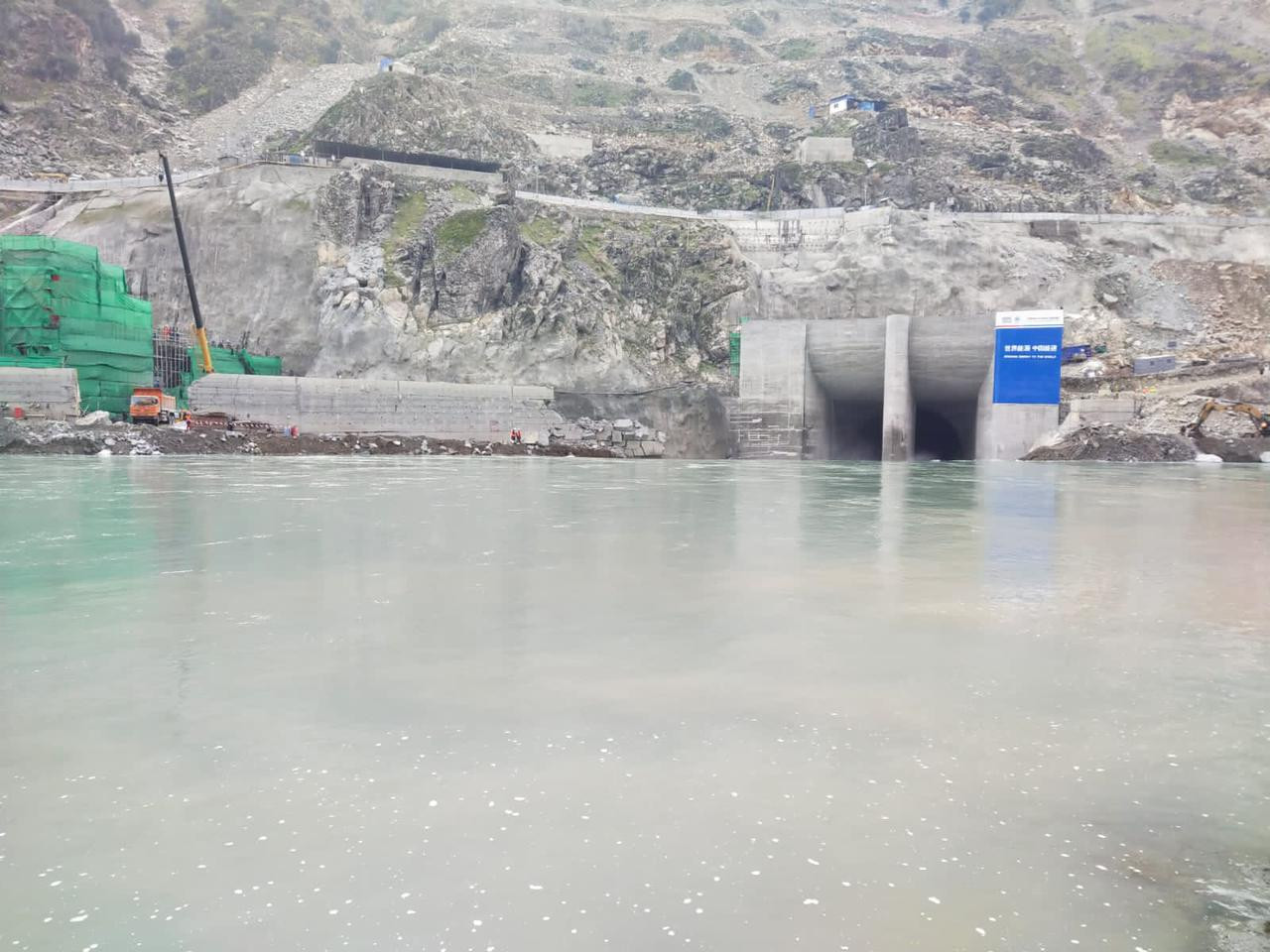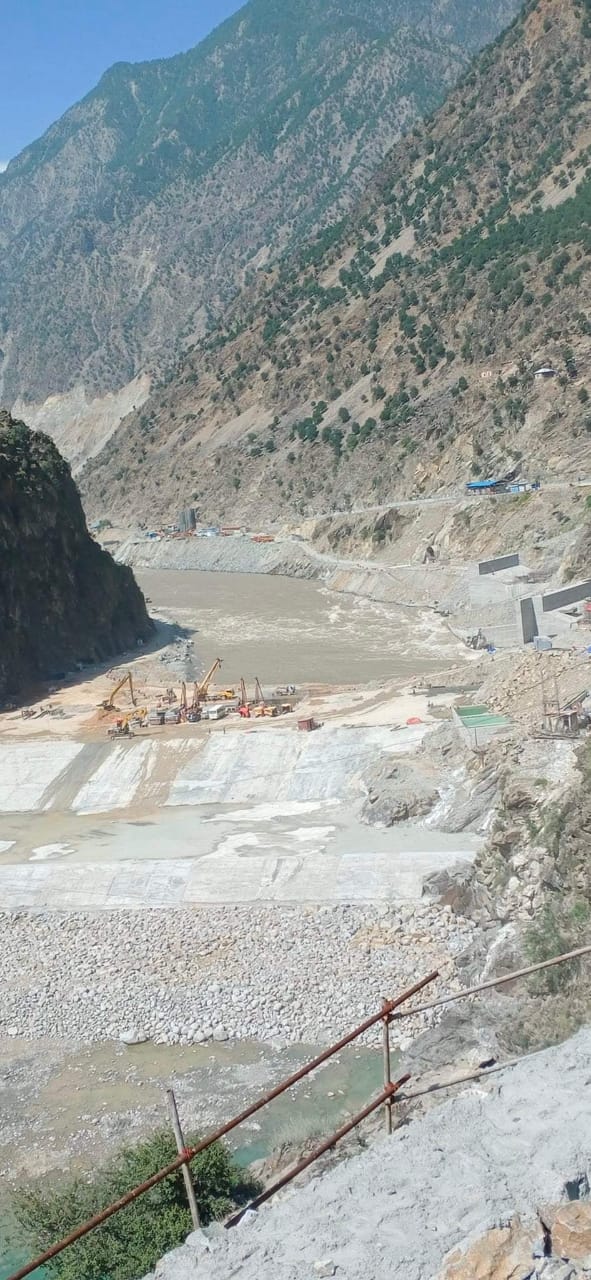How to install the app on iOS
Follow along with the video below to see how to install our site as a web app on your home screen.
Note: This feature may not be available in some browsers.
You are using an out of date browser. It may not display this or other websites correctly.
You should upgrade or use an alternative browser.
You should upgrade or use an alternative browser.
Dasu Hydropower Project (DHP), .... 4,320 MW
- Thread starter ghazi52
- Start date
ghazi52
PDF THINK TANK: ANALYST

- Joined
- Mar 21, 2007
- Messages
- 104,348
- Reaction score
- 106
- Country
- Location
,.,..,.
Zafar Bhutta
February 19, 2023
Indus River was successfully diverted following the completion of one of the two diversion tunnels at the under-construction Dasu hydropower project in Kohistan District, Khyber-Pakhtunkhwa (K-P).
Instead of its natural course, the river is now flowing through a 1.33-kilometre (Km) long diversion tunnel with a 20-metre (m) width and 23-m height.
Consequently, construction activities have been initiated on the starter dam, leading toward the construction of the main dam of the Dasu hydropower project.
The diversion of the mighty river was witnessed by the general manager and project director of the project, representatives of contractors and consultants, along with a number of engineers and workers.

Meanwhile, Water and Power Development Authority (Wapda) Chairman Lt General (retd) Sajjad Ghani congratulated the project management on achieving this milestone.
The diversion system of the Dasu hydropower project comprises two tunnels – tunnel A and tunnel B. Of these, the latter is complete, which has the discharge capacity, sufficient to divert the water from Indus River during the current lean-flows season.
The 1.5-km long tunnel A, with a 20-m width and 23-m height, will also be ready by mid-April this year to cater to the increased water flows during the high-flow season.

The project is a vital component of the least-cost, green and clean energy generation plan of WAPDA.
The 4320 MW-Dasu hydropower project is planned to be completed in two stages.
At present, WAPDA is constructing its stage-I with an installed generation capacity of 2160 MW and annual energy generation of 12 billion units and is likely to start electricity generation in 2026.
The 2160 MW stage-II, when implemented, will also provide nine billion units to the national grid.
On the completion of both stages, Dasu will become a project with the highest annual energy generation in Pakistan (ie 21 billion units per annum on average).
Indus River diverted at Dasu hydropower project site
Stage-I of the project likely to start electricity generation in 2026Zafar Bhutta
February 19, 2023
Indus River was successfully diverted following the completion of one of the two diversion tunnels at the under-construction Dasu hydropower project in Kohistan District, Khyber-Pakhtunkhwa (K-P).
Instead of its natural course, the river is now flowing through a 1.33-kilometre (Km) long diversion tunnel with a 20-metre (m) width and 23-m height.
Consequently, construction activities have been initiated on the starter dam, leading toward the construction of the main dam of the Dasu hydropower project.
The diversion of the mighty river was witnessed by the general manager and project director of the project, representatives of contractors and consultants, along with a number of engineers and workers.

Meanwhile, Water and Power Development Authority (Wapda) Chairman Lt General (retd) Sajjad Ghani congratulated the project management on achieving this milestone.
The diversion system of the Dasu hydropower project comprises two tunnels – tunnel A and tunnel B. Of these, the latter is complete, which has the discharge capacity, sufficient to divert the water from Indus River during the current lean-flows season.
The 1.5-km long tunnel A, with a 20-m width and 23-m height, will also be ready by mid-April this year to cater to the increased water flows during the high-flow season.

The project is a vital component of the least-cost, green and clean energy generation plan of WAPDA.
The 4320 MW-Dasu hydropower project is planned to be completed in two stages.
At present, WAPDA is constructing its stage-I with an installed generation capacity of 2160 MW and annual energy generation of 12 billion units and is likely to start electricity generation in 2026.
The 2160 MW stage-II, when implemented, will also provide nine billion units to the national grid.
On the completion of both stages, Dasu will become a project with the highest annual energy generation in Pakistan (ie 21 billion units per annum on average).
ghazi52
PDF THINK TANK: ANALYST

- Joined
- Mar 21, 2007
- Messages
- 104,348
- Reaction score
- 106
- Country
- Location
ghazi52
PDF THINK TANK: ANALYST

- Joined
- Mar 21, 2007
- Messages
- 104,348
- Reaction score
- 106
- Country
- Location
.,.,
4320 MW Dasu Dam Hydropower Project Under Construction
The first bin of the longitudinal guide wall of the Diamer Basha Dam Project of #POWERCHINA was recently poured, marking the end of the excavation task and the beginning of the concrete-pouring stage of the diversion tunnel project.
During the construction, the team actively communicated with all parties, optimized the excavation and pumping methods, and deployed sufficient workers to the construction site.
With all the challenges overcome, the team successfully completed the excavation task.
In the next step, POWERCHINA will target river diversion and closure to ensure safe flood-passing.


4320 MW Dasu Dam Hydropower Project Under Construction
The first bin of the longitudinal guide wall of the Diamer Basha Dam Project of #POWERCHINA was recently poured, marking the end of the excavation task and the beginning of the concrete-pouring stage of the diversion tunnel project.
During the construction, the team actively communicated with all parties, optimized the excavation and pumping methods, and deployed sufficient workers to the construction site.
With all the challenges overcome, the team successfully completed the excavation task.
In the next step, POWERCHINA will target river diversion and closure to ensure safe flood-passing.


ghazi52
PDF THINK TANK: ANALYST

- Joined
- Mar 21, 2007
- Messages
- 104,348
- Reaction score
- 106
- Country
- Location
,..,,.
Update large hydroelectric gravity dam currently under construction Indus River near Dasu Khyber Pakhtunkhwa.
242 meter tall. 4,320 MW hydropower Station, will be built in two 2,160 MW stages. The dam to start generating power in late 2024/25.
The main civil works, Gezhouba Group Company Limited
Update large hydroelectric gravity dam currently under construction Indus River near Dasu Khyber Pakhtunkhwa.
242 meter tall. 4,320 MW hydropower Station, will be built in two 2,160 MW stages. The dam to start generating power in late 2024/25.
The main civil works, Gezhouba Group Company Limited
ghazi52
PDF THINK TANK: ANALYST

- Joined
- Mar 21, 2007
- Messages
- 104,348
- Reaction score
- 106
- Country
- Location
,..,
AFP
April 05, 2023
A fire ripped through the camp of a Chinese company managing the construction of a remote hydropower dam in Khyber-Pakhtunkhwa on Tuesday, officials said.
Since 2015, Beijing has poured billions of dollars into Pakistan under an investment scheme known as the China Pakistan Economic Corridor (CPEC).
Private firms have also flooded over the border to service contracts on ambitious infrastructure projects, despite persistent threats from terrorist attacks.
Police said on Tuesday’s pre-dawn blaze ruined a warehouse complex for the Dasu hydropower project in the Kohistan district.
"It was a huge fire," a Rescue 1122 official at the site told AFP. "Initially, the flames were very high and we had to call for fire brigade vehicles from two other districts."
"It was quite a big storehouse, and apart from oil drums, stationery and machinery were also stockpiled there. That's all been destroyed in the fire," he added.
In 2017, the water ministry awarded the construction contract for the Dasu dam to the China Gezhouba Group Company.
The camp housed Chinese engineers, surveyors and mechanics, but both police and Rescue 1122 said none were injured or killed.
One police official said an electrical fault was the suspected cause of the fire.
In July 2021, 12 people -- including nine Chinese workers -- were killed aboard a bus carrying staff to the Dasu site, with Beijing insisting it was a bomb attack.
Fire breaks out at Dasu dam camp
Police said blaze ruined a warehouse complex for the Dasu hydropower project in the Kohistan districtAFP
April 05, 2023
A fire ripped through the camp of a Chinese company managing the construction of a remote hydropower dam in Khyber-Pakhtunkhwa on Tuesday, officials said.
Since 2015, Beijing has poured billions of dollars into Pakistan under an investment scheme known as the China Pakistan Economic Corridor (CPEC).
Private firms have also flooded over the border to service contracts on ambitious infrastructure projects, despite persistent threats from terrorist attacks.
Police said on Tuesday’s pre-dawn blaze ruined a warehouse complex for the Dasu hydropower project in the Kohistan district.
"It was a huge fire," a Rescue 1122 official at the site told AFP. "Initially, the flames were very high and we had to call for fire brigade vehicles from two other districts."
"It was quite a big storehouse, and apart from oil drums, stationery and machinery were also stockpiled there. That's all been destroyed in the fire," he added.
In 2017, the water ministry awarded the construction contract for the Dasu dam to the China Gezhouba Group Company.
The camp housed Chinese engineers, surveyors and mechanics, but both police and Rescue 1122 said none were injured or killed.
One police official said an electrical fault was the suspected cause of the fire.
In July 2021, 12 people -- including nine Chinese workers -- were killed aboard a bus carrying staff to the Dasu site, with Beijing insisting it was a bomb attack.
ghazi52
PDF THINK TANK: ANALYST

- Joined
- Mar 21, 2007
- Messages
- 104,348
- Reaction score
- 106
- Country
- Location
.,.,
Chairman WAPDA Engr Lt Gen Sajjad Ghani (Retd) visited under-construction Dasu Hydropower Project and reviewed construction work on starter dam, cut-of-wall and under-ground power house.
He was briefed that the second diversion tunnel is scheduled for completion in mid April, while cut-of-wall in mid May. River diversion system will also stand completed by mid May to pass through River Indus round-the-year.
The Chairman urged upon the project authorities to complete construction work as per the schedule. The 2160-MW Phase-I of Dasu Hydropower Project is likely to start electricity generation in 2026.


Chairman WAPDA Engr Lt Gen Sajjad Ghani (Retd) visited under-construction Dasu Hydropower Project and reviewed construction work on starter dam, cut-of-wall and under-ground power house.
He was briefed that the second diversion tunnel is scheduled for completion in mid April, while cut-of-wall in mid May. River diversion system will also stand completed by mid May to pass through River Indus round-the-year.
The Chairman urged upon the project authorities to complete construction work as per the schedule. The 2160-MW Phase-I of Dasu Hydropower Project is likely to start electricity generation in 2026.


ghazi52
PDF THINK TANK: ANALYST

- Joined
- Mar 21, 2007
- Messages
- 104,348
- Reaction score
- 106
- Country
- Location
.,.,
Construction work continues simultaneously on more than a dozen sites of Stage-I of the 4320 MW-Dasu Hydropower Project. Electricity generation from the project likely to commence in 2026...



Construction work continues simultaneously on more than a dozen sites of Stage-I of the 4320 MW-Dasu Hydropower Project. Electricity generation from the project likely to commence in 2026...



ghazi52
PDF THINK TANK: ANALYST

- Joined
- Mar 21, 2007
- Messages
- 104,348
- Reaction score
- 106
- Country
- Location
.,.,.
Construction highlights on Stage-I of the 4320 MW-Dasu Hydropower Project, being constructed on River Indus in Upper Kohistan, Khyber Pakhtunkhwa. Power generation from the project expected to start in 2026.
Picture highlights of construction progress at the first phase of Dasu Hydropower Project with a production capacity of four thousand 320 MW; electricity generation from the under-construction project on the Sindh River in Upper Kohistan district of Khyber Pakhtunkhwa is expected to commence in 2026.



Construction highlights on Stage-I of the 4320 MW-Dasu Hydropower Project, being constructed on River Indus in Upper Kohistan, Khyber Pakhtunkhwa. Power generation from the project expected to start in 2026.
Picture highlights of construction progress at the first phase of Dasu Hydropower Project with a production capacity of four thousand 320 MW; electricity generation from the under-construction project on the Sindh River in Upper Kohistan district of Khyber Pakhtunkhwa is expected to commence in 2026.



ghazi52
PDF THINK TANK: ANALYST

- Joined
- Mar 21, 2007
- Messages
- 104,348
- Reaction score
- 106
- Country
- Location
.,.,
Relocation of KKH - DASU HYDROPOWER PROJECT
Under construction of Dogah Road Tunnel
It is one of the 7 tunnels being constructed under relocated KKH component. The realigned and alternative road is being constructed by WAPDA in place of the existing submerged KKH under Dasu HPP Kohistan. The realigned KKH will be constructed in two phases KKH-01 and KKH -02.



.
Relocation of KKH - DASU HYDROPOWER PROJECT
Under construction of Dogah Road Tunnel
It is one of the 7 tunnels being constructed under relocated KKH component. The realigned and alternative road is being constructed by WAPDA in place of the existing submerged KKH under Dasu HPP Kohistan. The realigned KKH will be constructed in two phases KKH-01 and KKH -02.



.
Similar threads
- Replies
- 1
- Views
- 1K
- Replies
- 6
- Views
- 1K
- Replies
- 1
- Views
- 1K
- Replies
- 2
- Views
- 2K












